
It allows to keep PV going, with more focus towards AI, but keeping be one of the few truly independent places.
-
@LP others, my bad, should of explained better. I am worried that I was taking some test images in the lounge in artificial light and the tv is switched on ie if I video the tv its flickering like mad? I dont always video the tv lol, but I have never seen it flicker before or I can eliminate it ie if I reduced the shutter to 1/25 or 1/50 before on other patches or the stock f/w then the flicker would go, as the frequencies are matched? Interestingly no lights or anything else is flickering, just the tv? Does the camera need a full reset, is it thinking is ntsc even though its set for pal?
-
@kovtun66 yep manuals do look a little smoother. I confirmed this by taping up the contacts of my Panny primes (see http://www.personal-view.com/talks/discussion/546/gh2-digital-sharpening-removable-with-hack/p3). AFAIK there's no way to defeat that sharpening yet (but I'm just listening in here at the mo, v. busy).
One thing nobody tried (to my knowledge) was selectively taping up the lens contacts - the idea is that maybe you can keep focus control but trick the body into disabling the corrections.
-
@adventsam Many flatscreen TVs for the home these days are actually 60 Hz models (i.e. 60 Hz refresh rate), even if they can display PAL.
@kovtun66 Driftwood's Sedna C is softening the image to some degree, might help with reducing the sharpening with Panny lenses.
-
@LPowell - Well, I shoot everything on Smooth -2, -2, -2, -2. And I purposedly underexposed the shot (or rather, exposed for the highlights in this very contrasty subject: my gallery-patio) because I had found that problem (for me at least) in the lows when shooting indoors the night before. I lifted the gamma so the compression artifacts would be clear. In normal situations I would mos likely light the scene and get the look I want (specially in such a difficult contrast situation like this one) but whenever I wanted to leave dark areas on purpose I would like to have more detail. I made a comparison with a much higher Mbps patch, that's on top of that is intra, I know. But what bothers me is that the EOSHD Unified patch (which now I know was based off of driftwood's patches, so it's all Orion) also keeps details in the dark areas, and it's 88Mbps.
On the other hand, I know 720p60 and 1080p24 don't get along, so perhaps I'm asking for too much?
Anyways, here's the raw clip so you can check it! http://www.sendspace.com/file/9m3tmd
-
Shot with Flowmotion 2.01 patch
-
@charlie_orozco Thank you for sending me your original GH2 Flow Motion v2 test footage and permitting me to embed it here. I think this is a very good example of one of the most difficult shooting situations, a high-contrast scene with near-black shadow details. What's challenging is that enhancing the shadows in this case involves not only a technical gamma correction - it needs something of an artistic touch to render the coarsely encoded data in a naturalistic manner.
The problematic issue with shadow details is that the image sensor resolves them as full-color RGB data, where it should really be desaturating the shadows as they fade into black. In preserving over-saturated hues of shadow areas, the camera fails to account for the fact that to the human eye, pure blues and purples appear much darker than other shades that may be recorded at the same illumination levels. With care, this undesirable psycho-visual effect can often be corrected in post.
One the most significant distinctions in Flow Motion v2 is how it smoothes out low-level chroma noise while fully preserving luminance detail, both in shadows and highlights. This makes the AVCHD encoder behave more like the way human vision works: high-resolution perception of contrast combined with low-resolution perception of color.
Here is the original GH2 Flow Motion v2 test footage with near-black shadow details:
I used Adobe After Effects CS5.5 to produce this color-graded version with enhanced shadow details. No filters were used to add or remove shadow noise from the video:
-
Still getting the errors with Version 2.1 for 720p High "P" mode with Auto ISO and the 30 mb/sec Sandisk card.
The failure for SH mode occurred with both the 25mm F1.4 lens and the 14-140mm lenses in a darker room with AFC. This probably will not be a huge issue for most people but it is something to be aware of.
I am very interested in testing pure black scenes like the one you posted above for Astro Photography. There is a full moon on Monday. I am going to try to video that with the 2.1 settings. I am interested in seeing if the Black of space shows up better with these settings over more moderate settings.
-
@mpgxsvcd It would be very helpful if you could send me original MTS footage of a succesfully recorded video shot under conditions where you've seen the camera fail. Shooting extremely detailed subjects with a Panasonic 45-200mm f4-5.6 lens in "P" Still-Frame mode with both OIS and AFC auto-focus, I have been unable to reproduce any recording errors in 720p60 or 720p50 SH or H modes.
In broad daylight, "P" mode can often select undesirably high shutter speeds well over 1/125 second, which produces sharply-etched frames with virtually no motion blur. So far, I haven't been able to provoke Flow Motion v2.01 to fail under these conditions.
-
@CurtisMack I use Smooth Film Mode for daylight shots and Nostalgic for incandescent lighting, both set at -2,-2,-1, -2. However, I didn't shoot the Shadow Detail footage above, that was contributed by @charlie_orozco
-
Being one of those who had reported aborted recordings with FM 2.00 / 720p60, it took me a few days until the weather allowed to retry with FM 2.01 - but today there was sun & wind, again.
Alas, I have to report that FM 2.01 failed again, stopping the recording after only 8 seconds (on a freshly formatted SanDisk 64GB 95MB/s).
Find attached a screen-shot of the scene (just leaves of a tree moving in the wind, sun shining, GH2 mounted on a tripod), plus an animated GIF showing 12 frames near before the recording aborted. Recording parameters: 720p60 SH, shutter 1/200 (mode P), aperture 4.0, lens Panasonic Vario X PZ 14-42mm, f=~35mm was used, AFS.
If you would like to have the .MTS file (70 MB), too, please tell me where I could upload it (I don't have a vimeo account or alike).
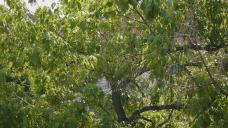
 fm2_tree_fail.jpg1280 x 720 - 446K
fm2_tree_fail.jpg1280 x 720 - 446K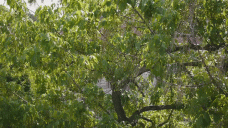
 fm201_fail.gif640 x 360 - 3M
fm201_fail.gif640 x 360 - 3M -
@karl Thanks for your test report, I'm familiar with those kind of windy conditions and with the info you provided I can reproduce your testing setup. Was this 720p60 only in still-frame P-mode, or in Creative Movie P-mode? Did you see it halt just once, on sporadic occasions, or repeatedly under the same conditions? Thanks, these details are very helpful in pinpointing the issue.
-
@LPowell: I shot the 720p60 samples in "Stills P-Mode".
I tried recording the same scene 3 times in a row, it stopped in all three cases, the first time after 8 seconds, the second time after 15 seconds, the third time after 12 seconds.
Since I had to revert the firmware due to the 720p60 issue anyway, I decided that I could just as well use the opportunity to take some more shots in 24H, first with FM-2.01, then with GOP3ZILLA-MAX_Standard_V2_BETA5, to do some image quality comparison.
I merged some test shots in 24H at ISO 160 (the tree), at ISO 3200, 6400 and 12800 (just some dark corner of a hallway with some stuff) into a short video, with the patch settings side by side.
I did not apply post-processing to the ISO 160 shot, but to the ISO 3200/6400/12800 shots I applied a spatial/temporal noise reduction filter, a level/gamma correction and a bezier-curve based desaturation of the darker parts, choosing the filter parameters such that I liked the FM 2.01 recorded footage best, then I copied the filters including all parameters to the video track that I had recorded using GOP3ZILLA (which gives the latter some disadvantage with regards to fitting my personal preference, but I wanted to use the same parameters for a better comparability).
Of course, everything but the ISO 160 shot were extreme conditions where the result is far from being ready for the cinema... ;-) - but I just wanted to know how the many adjustments in FM 2.01 work under these difficult conditions.
The screen shots that I appended to this post were taken from frames that I considered "fairly comparable" - I tried to choose frames where both settings deal with the same (low but not zero) amount of motion.
I think it is not easy to decide what actually looks better, from the ISO 160 and ISO 12800 shots I could not assign a winner. In the ISO 3200 and 6400 shots, I think GOP3ZILLA retains a little more details, but it also has a little more contrast, which may or may not be a good thing. In the end, it's probably a matter of taste - and others may have preferred other postprocessing settings, of course.
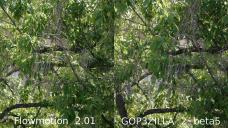
 fm2_vs_gop3zilla_iso160.jpg1920 x 1080 - 1M
fm2_vs_gop3zilla_iso160.jpg1920 x 1080 - 1M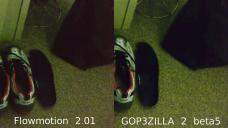
 fm2_vs_gop3zilla_iso3200.jpg1920 x 1080 - 444K
fm2_vs_gop3zilla_iso3200.jpg1920 x 1080 - 444K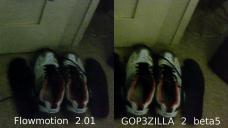
 fm2_vs_gop3zilla_iso6400a.jpg1920 x 1080 - 426K
fm2_vs_gop3zilla_iso6400a.jpg1920 x 1080 - 426K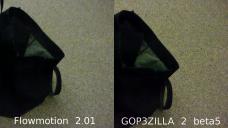
 fm2_vs_gop3zilla_iso6400.jpg1920 x 1080 - 579K
fm2_vs_gop3zilla_iso6400.jpg1920 x 1080 - 579K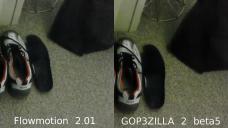
 fm2_vs_gop3zilla_iso12800.jpg1920 x 1080 - 416K
fm2_vs_gop3zilla_iso12800.jpg1920 x 1080 - 416K -
@karl Thanks for your detailed reply. This sounds like the same issue that @mpgxsvcd reported above, and that I was able to confirm as well. In my tests it occurred only when shooting 720p SH in Still-Frame P-mode with an auto-focus lens. I've observed no recording failures in any of the Creative Movie video modes.
Since Still-Frame P-mode can't use 24H or HBR modes and doesn't give you direct control of shutter speed, I haven't tested it a great deal with Flow Motion v2.01. However, there is a workaround for those who find this fully automated mode useful. With Still-Frame P-mode, 720p "H" mode will work reliably at a 60Mbps peak bitrate, with image quality significantly improved over stock firmware.
-
@LPowell - I'm able to reproduce the error in 720p SH creative movie mode using the 14-140 panny lens. I usually produce write/speed errors when focusing (shutter half-press) or exposure changes (aperture) during filming. Sandisk 16GB Extreme 30MB/s Class 10
On the flip side, the footage quality is spectacular.
Let me know if you want the MTS
-
@v10tdi Thanks, I'll see if I can provoke recording errors with shutter-button focusing during 720p video shooting. I take it the aperture changes you referred to are produced by zooming the 14-140mm lens at a wide-open aperture setting?
If it's able to save a non-zero file after being provoked to halt recording, the MTS file could provide useful clues.
-
@v10tdi I tried every kind of shutter-button focusing trick I could think of, but still couldn't find a way to provoke a recording error in 720p60 Creative Movie Mode in the "P" setting. I was using a Panasonic Lumix 45-200mm lens in OIS and AFS mode, and zooming occasionally to alter the aperture setting. I don't have access to a 14-140mm zoom, so if it's something specific to that particular lens, I don't have a way to test for it.
-
I need HBR in detailed shots so I made a test with 24p and HBR 30p on a tripod. I uploaded directly the MTS files. Both are spectacular.
BTW I discovered that the Vimeo codec from straight AVCHD 1080p sucks. Looks at the original mts files.
116Mbps for 24p and 57 Mbps for 30p
Howdy, Stranger!
It looks like you're new here. If you want to get involved, click one of these buttons!
Categories
- Topics List23,993
- Blog5,725
- General and News1,354
- Hacks and Patches1,153
- ↳ Top Settings33
- ↳ Beginners256
- ↳ Archives402
- ↳ Hacks News and Development56
- Cameras2,368
- ↳ Panasonic995
- ↳ Canon118
- ↳ Sony156
- ↳ Nikon96
- ↳ Pentax and Samsung70
- ↳ Olympus and Fujifilm102
- ↳ Compacts and Camcorders300
- ↳ Smartphones for video97
- ↳ Pro Video Cameras191
- ↳ BlackMagic and other raw cameras116
- Skill1,960
- ↳ Business and distribution66
- ↳ Preparation, scripts and legal38
- ↳ Art149
- ↳ Import, Convert, Exporting291
- ↳ Editors191
- ↳ Effects and stunts115
- ↳ Color grading197
- ↳ Sound and Music280
- ↳ Lighting96
- ↳ Software and storage tips266
- Gear5,420
- ↳ Filters, Adapters, Matte boxes344
- ↳ Lenses1,582
- ↳ Follow focus and gears93
- ↳ Sound499
- ↳ Lighting gear314
- ↳ Camera movement230
- ↳ Gimbals and copters302
- ↳ Rigs and related stuff273
- ↳ Power solutions83
- ↳ Monitors and viewfinders340
- ↳ Tripods and fluid heads139
- ↳ Storage286
- ↳ Computers and studio gear560
- ↳ VR and 3D248
- Showcase1,859
- Marketplace2,834
- Offtopic1,320












